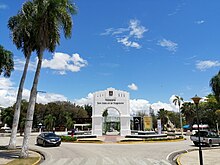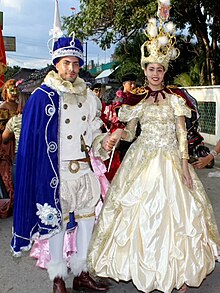| San Juan de la Maguana | |
|---|---|
 Cathedral of San Juan de la Maguana, Dominican Republic Cathedral of San Juan de la Maguana, Dominican Republic | |
 Seal Seal | |
 | |
| Coordinates: 18°48′36″N 71°13′48″W / 18.81000°N 71.23000°W / 18.81000; -71.23000 | |
| Country | |
| Province | San Juan |
| Founded | 1503; 1733 |
| Area | |
| • Total | 1,876.21 km (724.41 sq mi) |
| Elevation | 415 m (1,362 ft) |
| Population | |
| • Total | 169,032 |
| • Density | 90/km (230/sq mi) |
| • Demonym | Sanjuanero(a) |
| Distance to – Santo Domingo | 200 km |
| Municipal Districts | 9 |
San Juan de la Maguana is a city and municipality in the western region of the Dominican Republic and capital of the San Juan province. It was one of the first cities established on the island; founded in 1503, and was given the name of San Juan de la Maguana by San Juan Bautista and the Taino name of the valley: Maguana. The term Maguana means "the first stone, the unique stone".
Geography
San Juan de la Maguana is in the center of Valley of San Juan with the Central ("Cordillera Central") mountain range to the north and east, and the Sierra de Neiba to the south. To the west there is a range of low hills. The San Juan River is the main river of the region, and the city was founded on the eastern side of this river.
History
San Juan de la Maguana is one of the oldest cities in the country . It occupies the same valley where the chiefdom seat had Maguana and the historic "Corral of the Indians". Their leader and warlord was Caonabo (which in the aboriginal language means "great lord of the earth"), he this chief led one of the most notable battles against the Spanish colonizers.
Alonso de Ojeda captured Caonabo in a ruse. Caonabo's town later became the site of San Juan de la Maguana, founded by Rodrigo Mejia Trillo.
San Juan de la Maguana was founded in 1503 by Diego Velázquez. However, the town experienced little growth and was largely depopulated by 1574 and abandoned by 1605 as part of the Devastations of Osorio.

Starting in the late 17th century, the San Juan valley began to be inhabited again by colonists from other settlements in the colony and the Canary Islands. In 1733, the town of San Juan was founded once more, close to the site of the original settlement. The town grew steadily during the 18th century, with a population of 1,851 according to a census done in 1777; of them, 1,223 were free and 618 were enslaved. Like many towns in the region at the time, the primary economic activity was cattle ranching. The town exported hundreds of cattle to the neighboring French colony of Saint-Domingue, surpassed in volume only by the towns of Hincha (now part of Haiti as Hinche) and El Seibo.
San Juan was temporarily ruled by the French when the Spanish colony was ceded to France under the Peace of Basel in 1795. It returned to Spanish jurisdiction in 1809 following the Spanish reconquest of Santo Domingo. In 1820, president Jean-Pierre Boyer of Haiti sent Dézir Dalmassi to San Juan and other cities to amass support for the incoming annexation. In 1821, San Juan became part of the short-lived Republic of Spanish Haiti, which would later be annexed by the Republic of Haiti (1820–1849) the following year. During this time, the city was known as Saint-Jean de la Maguâna and was part of the department of Ozama in the Haitian state.
The eastern part of Hispaniola declared independence as the Dominican Republic on February 27, 1844, and San Juan became part of the province of Azua. Haitian forces would attempt to recapture the east in a 12-year war; one of these battles, the Battle of Santomé, took place close to San Juan. Dominican forces prevailed and San Juan and surrounding areas remained a part of the Dominican Republic.

Since its inception San Juan flourished due to its fertile lands and climate. a diverse range of fruits were grown in the town; the exploitation of sugarcane as a commercial item of importance, were the main line for the employment of labor. San Juan possessed in principle four "mills" for the exploitation of cane. The first of these mills was installed in the center of town.
Economy
The main economic activities in the province are livestock and agriculture; as it has been since the since colonial times thanks to the fertile soil and climate which is suitable for cultivation of cereals and legumes such as beans, rice, corn, peanuts, pigeon peas, and sorghum.
 San Juan residential buildings panoramic view
San Juan residential buildings panoramic view
Culture
The patron saint festivities of San Juan de la Maguana are celebrated on June 24 of each year, the day of San Juan Bautista. San Juan is known on the island for hosting a diversity of cultural traditions. It is known as "Fiesta de palos", which is a ritual done from time to time in the municipality. Figures are made to which magical powers are attributed, called Witches of San Juan.

In addition, evangelical Christianity has gained a significant presence in the local community, being one of the most growing religious communities in recent years composed mostly of young people. There is also the presence of Jehovah's Witnesses, members of the Church of Jesus Christ of Latter-day Saints, and other religious denominations related to Christianity.
Climate
Owing to its location in a sheltered basin, San Juan de la Maguana has a relatively dry tropical savanna climate (Köppen Aw). Maxima are hot year-round, although the city’s moderate altitude lessens humidity somewhat and cools the mornings by around 4 to 5 °C (7 to 9 °F). There is a very pronounced dry season from December to March, when only 76.9 millimetres or 3.03 inches of rain can be expected, and a moderate wet season covering the remainder of the year
| Climate data for San Juan de la Maguana (1961–1990) | |||||||||||||
|---|---|---|---|---|---|---|---|---|---|---|---|---|---|
| Month | Jan | Feb | Mar | Apr | May | Jun | Jul | Aug | Sep | Oct | Nov | Dec | Year |
| Record high °C (°F) | 33.9 (93.0) |
35.5 (95.9) |
36.8 (98.2) |
36.2 (97.2) |
36.2 (97.2) |
37.0 (98.6) |
39.0 (102.2) |
37.5 (99.5) |
37.5 (99.5) |
36.9 (98.4) |
35.0 (95.0) |
33.5 (92.3) |
39.0 (102.2) |
| Mean daily maximum °C (°F) | 29.6 (85.3) |
30.4 (86.7) |
31.4 (88.5) |
31.5 (88.7) |
31.0 (87.8) |
31.8 (89.2) |
32.7 (90.9) |
32.7 (90.9) |
32.2 (90.0) |
31.0 (87.8) |
30.1 (86.2) |
29.6 (85.3) |
31.2 (88.2) |
| Mean daily minimum °C (°F) | 15.3 (59.5) |
16.1 (61.0) |
17.4 (63.3) |
18.9 (66.0) |
19.9 (67.8) |
20.1 (68.2) |
19.6 (67.3) |
19.8 (67.6) |
19.8 (67.6) |
19.5 (67.1) |
18.1 (64.6) |
15.9 (60.6) |
18.4 (65.1) |
| Record low °C (°F) | 8.5 (47.3) |
8.7 (47.7) |
9.4 (48.9) |
11.8 (53.2) |
13.7 (56.7) |
15.6 (60.1) |
13.5 (56.3) |
15.5 (59.9) |
13.5 (56.3) |
14.0 (57.2) |
10.1 (50.2) |
7.2 (45.0) |
7.2 (45.0) |
| Average rainfall mm (inches) | 12.1 (0.48) |
15.4 (0.61) |
31.2 (1.23) |
69.3 (2.73) |
141.5 (5.57) |
90.2 (3.55) |
108.3 (4.26) |
128.2 (5.05) |
148.4 (5.84) |
134.7 (5.30) |
53.1 (2.09) |
18.2 (0.72) |
950.6 (37.43) |
| Average rainy days (≥ 1.0 mm) | 1.5 | 1.8 | 3.1 | 5.9 | 9.7 | 7.9 | 7.7 | 8.9 | 10.3 | 10.8 | 4.8 | 1.5 | 73.9 |
| Average relative humidity (%) | 70.1 | 68.5 | 67.3 | 69.5 | 73.3 | 72.0 | 69.8 | 70.2 | 72.3 | 75.4 | 73.8 | 71.3 | 71.1 |
| Source: NOAA | |||||||||||||
Demographics
According to the 2012 Population and Housing Census, the municipality had a total population of 169,032. The urban population of the municipality was 60.10%. These population data include the populations of the municipal districts.
Notable people
- Sandy Alcantara, Major League Baseball pitcher
- Jean Segura, Major League Baseball Player
- Francisco Alberto Caamaño, Expresident of the Dominican Republic
- Danilo Medina, Expresident of the Dominican Republic
- Jose Joaquin Puello, Dominican revolutionary and military general
- Manuela Rodríguez Aybar (c. 1790 - 1850), poet
References
- Superficies a nivel de municipios, Oficina Nacional de Estadistica Archived 2009-04-17 at the Wayback Machine
- De la Fuente, Santiago (1976). Geografía Dominicana (in Spanish). Santo Domingo, Dominican Republic: Editora Colegial Quisqueyana.
- Censo 2012 de Población y Vivienda, Oficina Nacional de Estadistica
- "ayuntamientosanjuan.gob.do/historia". ayuntamientosanjuan.gob.do.
- Floyd, Troy (1973). The Columbus Dynasty in the Caribbean, 1492-1526. Albuquerque: University of New Mexico Press. pp. 28–29, 63.
- Vidal, Pedro Luciano Vergés. Anacaona (1474–1503), p. 195
- Hernández González, Manuel (2005). La colonización de la frontera dominicana (1680-1795) [The colonization of the Dominican border (1680-1795)] (in Spanish). Ediciones IDEA. p. 255. ISBN 84-96505-34-0.
- Peguero, Valentina; de los Santos, Danilo (1983). Vision general de la historia Dominicana [Overview of Dominican History] (in Spanish). Santo Domingo, Dominican Republic: Editora Corripio, C. por A. pp. 78–79.
- Hernández González, Manuel (2005). La colonización de la frontera dominicana (1680-1795) [The colonization of the Dominican border (1680-1795)] (in Spanish). Ediciones IDEA. pp. 256–261. ISBN 84-96505-34-0.
- Peguero, Valentina; de los Santos, Danilo (1983). Vision general de la historia Dominicana [Overview of Dominican History] (in Spanish). Santo Domingo, Dominican Republic: Editora Corripio, C. por A. pp. 131–155.
- Peguero, Valentina; de los Santos, Danilo (1983). Vision general de la historia Dominicana [Overview of Dominican History] (in Spanish). Santo Domingo, Dominican Republic: Editora Corripio, C. por A. pp. 179–207.
- "San Juan Climate Normals 1961-1990". National Oceanic and Atmospheric Administration. Retrieved September 19, 2016.